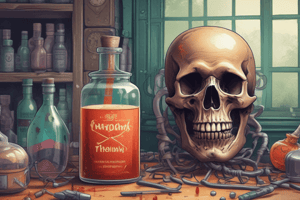Podcast
Questions and Answers
What is the main characteristic that distinguishes persistent chemical weapons from non-persistent chemical weapons?
What is the main characteristic that distinguishes persistent chemical weapons from non-persistent chemical weapons?
- Persistent agents evaporate quickly
- Non-persistent agents have low volatility
- Persistent agents dissipate slowly (correct)
- Non-persistent agents cause tissue damage
Which type of chemical weapon agent is commonly known as mustard agents?
Which type of chemical weapon agent is commonly known as mustard agents?
- Blood agents
- Choking agents
- Nerve agents
- Blistering agents (correct)
Which of the following substances is classified as a blister agent?
Which of the following substances is classified as a blister agent?
- Sulphuric acid
- Lewisite (L) (correct)
- Hydrogen peroxide
- Sodium chloride
What is the recommended treatment for skin and mucous membrane decontamination due to chemical exposure?
What is the recommended treatment for skin and mucous membrane decontamination due to chemical exposure?
In the context of protection and decontamination from chemical exposure, what should be worn for general protection?
In the context of protection and decontamination from chemical exposure, what should be worn for general protection?
Which type of chemical agent causes wounds that resemble blisters or burns?
Which type of chemical agent causes wounds that resemble blisters or burns?
What is the appropriate substance for cleaning all exposed materials after a chemical exposure incident?
What is the appropriate substance for cleaning all exposed materials after a chemical exposure incident?
What is the main characteristic of blister agents among chemical weapons?
What is the main characteristic of blister agents among chemical weapons?
Which of the following is not a substance classified as a blister agent?
Which of the following is not a substance classified as a blister agent?
What type of care is recommended for skin and mucous membrane decontamination due to chemical exposure?
What type of care is recommended for skin and mucous membrane decontamination due to chemical exposure?




